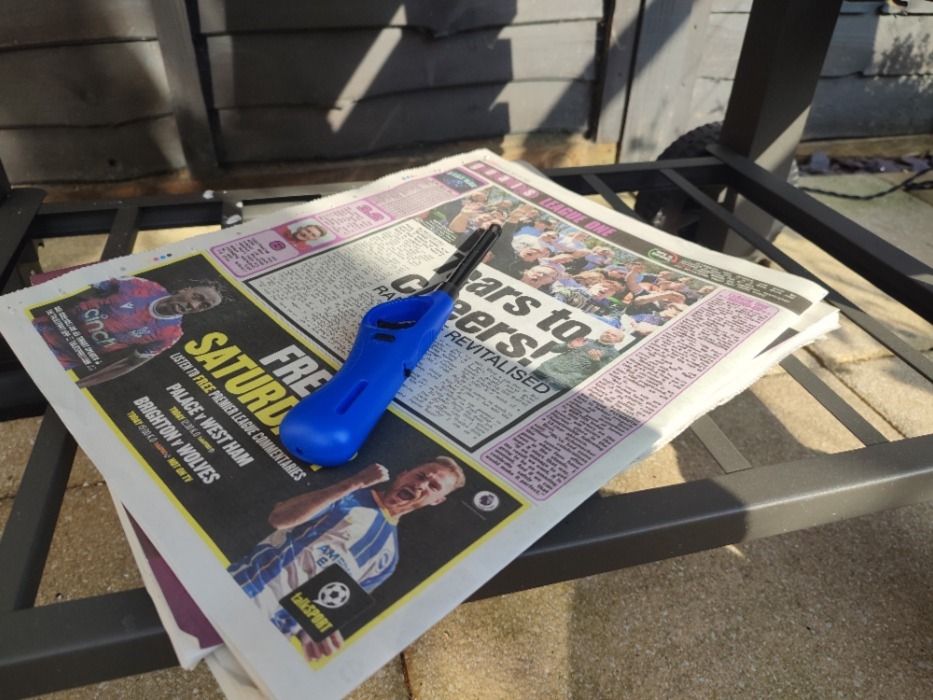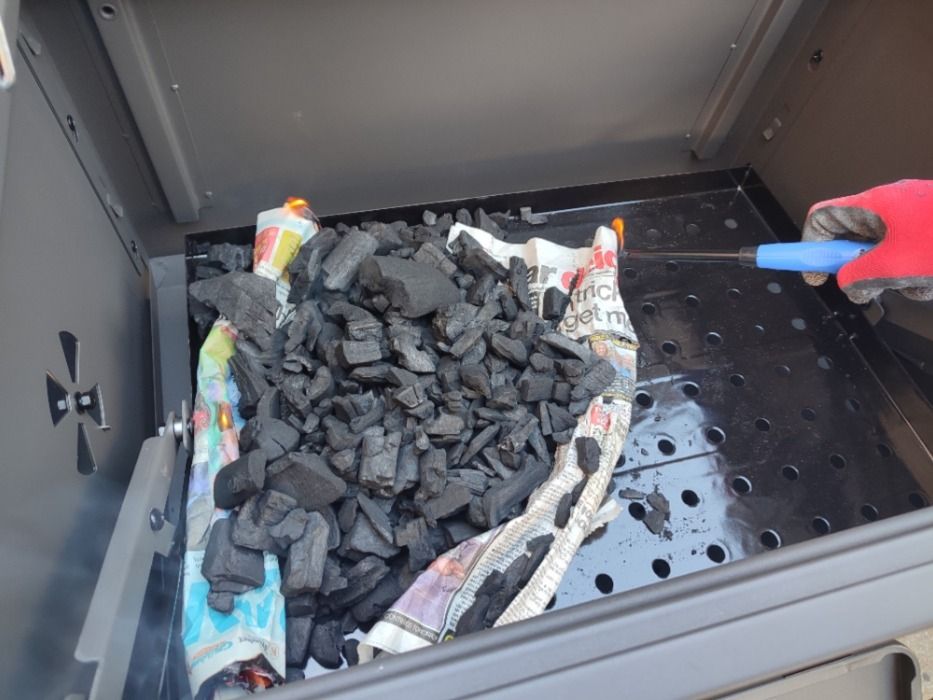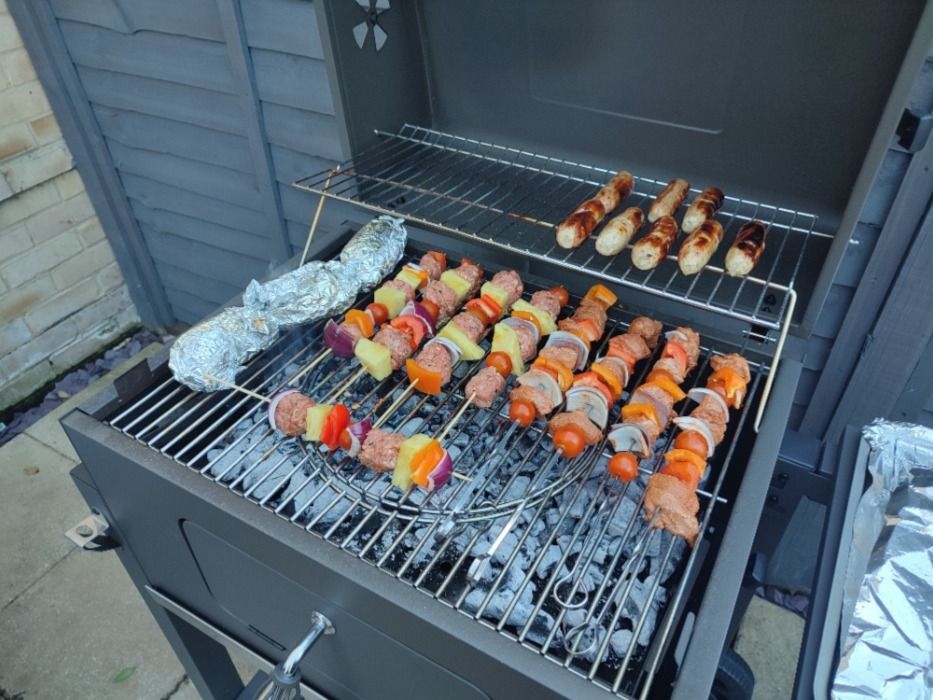
Having a BBQ in the sun is one of the guilty pleasures of the summer season. Because, seriously, what beats having a BBQ with family and friends?
The smoky flavour from grilled meat is just the icing on the cake.
However, it’s easy to look at a new charcoal BBQ and wonder – where do I start?
In this article, we’ll give you a detailed guide on this process, including a list of the items you’ll need to get started, helpful tips that’ll ease you into starting your charcoal BBQ, and a step-by-step guide on how to start your BBQ.
Items You’ll Need to Start a Charcoal BBQ
It’s always better to start on the right foot. In this case, that means getting your items ready ahead of time.
To start your charcoal BBQ, you’ll need:
- Lump charcoal or charcoal briquettes (around 5-6lb for a standard BBQ or more for larger BBQs)
- Long matches or a long lighter
- Fire starters (e.g., lighter cubes, sheets of newspaper, paper towels, etc.)
- A charcoal chimney starter (optional but very helpful!)
Helpful Tips Before You Get Started
There’s nothing worse than inviting everyone over only to have BBQ troubles.
After all, charcoal grills are harder to work than electric or gas grills.
Follow these tips to ensure your BBQ’s temperature is just right and your meat is perfectly cooked.
1. Buy High-Quality Charcoal
Like anything, buying higher-quality charcoal can make your life much easier.
While the cheapest coal in the supermarket may appear beneficial for your budget, it won’t be in the long run. Why?
Manufacturers typically pack cheap coal with harsh chemicals to help the coal catch.
This may sound dreamy to someone getting to grips with a charcoal BBQ for the first time. But there are several drawbacks of this type of charcoal:
- It has a shorter burn time, meaning you’ll need more of it and must top it up continually.
- Cheap charcoal is often made from low-quality products, which affects the heat it produces – it may create inconsistent heat.
- Cheap coal produces more ash, meaning a bigger clean-up job later.
- The chemical additives cheap coal often contains can be harmful to your health.
So, what’s the right type of charcoal? There are two: charcoal briquettes and natural lump charcoal.
The right charcoal for you depends on what you want. Here are some pros and cons for each.
| Type of Charcoal | What It Is | Pros | Cons |
| Charcoal Briquettes | Made from compressed charcoal dust and a binding agent like sawdust or borax. |
|
|
| Natural Lump Charcoal | Made from hardwood burnt without oxygen in a process called pyrolysis. |
|
|
2. Keep Your BBQ On a Flat Level
This tip is common sense but something people may not consider.
As you’ll effectively be starting a fire, and your coals will remain hot for up to 48 hours after grilling, you must keep your BBQ on a flat level when you begin.
This prevents unnecessary rocking or tipping, keeping you and your garden safe from fires!
3. Consider Creating a Split-Level Fire
A split-level charcoal fire is the classic two-zone charcoal arrangement (more on how to do this later!).
A split-level fire simply means piling half of your grill up with charcoal and leaving the other side empty.
This provides a space for direct heat and a space for indirect heat.
While most people think they should simply load their coals up onto the bottom of their grill, a split-level fire can be extremely useful for various reasons:
- You can cook different types of meat – Some meat needs to be cooked directly, while others need lower temperatures and slower indirect heat cooking.
For example, sausages need 8-10 minutes of cooking over indirect heat before chargrilling over direct heat.
Similarly, you’ll want to sear steaks on the direct heat before moving them over to the cooler spot.
However, meat such as kebabs and thin burgers love direct heat through and through!
- You can cook vegetables without cremating them – Vegetables don’t typically need the fiery heat of an open flame. A split-level fire helps you cook these low and slow to perfection.
- You can smoke and barbecue food – Smoking and barbecuing food require low temperatures for long durations. You can’t achieve this with the high temperature of direct heat, so you’ll need a split-level fire!
READ NEXT: Barbecuing vs Smoking vs Grilling – What Is the Difference?
4. Stay Away From Lighter Fluid!
Lighter fluid is one of, if not the most well-known, supermarket fire starter out there.
But here’s the problem – lighter fluid contains harsh chemicals that may harm your health.
The chemicals lighter fluid contains also give off a strong odour when burnt, altering your food’s flavour.
Lighter fluid can completely overpower meats with a subtle taste like pork, chicken, or vegetables.
Furthermore, it’s better not to have lighter fluid around your house if you can help it.
It’s highly flammable and, if not handled correctly, can cause big BBQ fires that are difficult to extinguish.
And then there are the environmental concerns.
Lighter fluid contains petroleum products which don’t biodegrade and is considered “hazardous waste,” so they can’t simply be thrown into your household bin.
How to Start a Charcoal BBQ: Simple Step-By-Step Guide
1. Clean Your Grill
If you have been given a hand-me-down BBQ, chances are, it’ll need a good and thorough clean before use – this is especially true if it’s rusty.
There are several reasons why cleaning a used BBQ is a good idea:
- Leftover debris, grease, or ash can cause a fire hazard.
- Harmful bacteria and microorganisms love old food debris. If you’re working on a dirty grill, you are more at risk of food poisoning.
- Cleaning your BBQ ensures better air circulation, helping your charcoal light evenly and providing consistent heat.
- It’ll improve your grill’s lifespan.
If you’re using a brand-spanking-new BBQ, you can go straight to the next step – you’re good to go without cleaning it.
READ NEXT: How to Clean a Rusty BBQ Grill
2. Arrange Your Charcoal
This may sound like a pointless step, but trust me – the proof is in the pudding with this one.
There are various ways to arrange your charcoal based on how you want to grill your food:
- Simple one-zone arrangement: The simple one-zone arrangement couldn’t get more straightforward – load the bottom of your grill up with a level layer of coals. This arrangement is the prime choice for traditional summer BBQs.
- Classic two-zone arrangement: This method creates a split-level fire. Simply load half your grill up with coals and leave the other half empty, creating a space for fiery direct heat and another for indirect heat.
- Snake method: Arrange unlit briquettes at a 45-degree angle along half your grill’s circumference. Create an arrangement that’s two rows wide. This method is perfect for producing low cooking temperatures for low and slow cooking. Add a drip pan of water in the centre and wood chips to the head of the snake for smoke if you wish!
- Minion method: You’ll need a charcoal chimney starter for this one! Arrange your unlit charcoal in a single-layer circle around the edge of your charcoal grate, then make a small pile of lit briquettes in the middle of the unlit pieces of charcoal. This allows you to cook for many hours without needing to add more charcoal midway through.
Now, it’s time to light the coals!
3. Light the Charcoal
The best way to light coals depends on the tools you have available.
If you have a charcoal chimney starter, this makes lighting your charcoal far easier.
However, you can also use newspaper or lighter cubes.
Before lighting your charcoal, remove the cooking grate – this helps give you easier access to the coals.
To light your coals with a charcoal chimney starter:
- Fill your chimney starter with charcoal. For low heat, slow cooking, and any size grill, fill your chimney 1/4 full. If you’re cooking on medium heat, with moderate cooking time, and your grill is medium-large, fill 1/2 or 3/4 of your chimney. And if you want to cook at a higher temperature quickly on a large grill, fill your chimney 3/4 full or to the brim.
- Add newspaper, paper towels, or lighter cubes in the chamber at the bottom of the starter. A great alternative if you don’t have any of these fire starters is dryer lint or cotton balls – many people don’t think of these!
- Use a long lighter or long matches to light your sheets of newspaper, paper towels, or lighter cubes. You can always add several drops of cooking oil (olive oil or vegetable oil) to give it a little helping hand, too.
- Monitor your chimney starter to wait for your charcoal to light – this could take up to 15 minutes. You can tell when your coals are lit by the amber glow in the starter. The top coals will also start turning colour to greyish-white.
- Dump your hot coals into the bottom of the grill in your chosen arrangement.
If you’re using the newspaper method:
- Scrunch up newspaper in balls or long tubes and place them in the bottom of your grill and dot it around where you plan to arrange your coals. Add a little cooking oil to help it catch.
- Place your charcoals around the newspaper, covering it enough that it’ll light while leaving enough space for the air to circulate.
- Light your newspaper with a long lighter – you’ll need to light every piece you put in; otherwise, your charcoal fire will be uneven. Open up the air vents to allow air to circulate but close your grill’s lid.
- Sit tight while your charcoal ignites. It takes slightly longer with the newspaper method. However, check back on it after around 15/20 minutes. It should be good to go! You know it’s ready when your coals turn a greyish-white.
If you have lighter cubes instead of newspaper, use the same method, but with lighter cubes!
4. Put the Grate Back On and Start Cooking!
All that’s left to do now is place your cooking grate back in its original position and start your charcoal grilling!
FAQs
What Do I Do With Leftover Charcoal?
If your leftover charcoal is still good to use, there’s no reason why you can’t store it for later.
However, if you’ve used it and it’s no longer good, allow it to cool completely (after up to 48 hours), then place it in a metal container or tin foil and dispose of it in your bin.
How Do I Light Charcoal Fast?
An easy way to light charcoal fast is by using a chimney charcoal starter.
However, you can also use a looft lighter, a form of electric charcoal starter.
An electric starter works by lighting your charcoals without needing any other material – so no need for matches, fire-starters, and definitely no lighter fluid!
Simply place your electric starter on the charcoal and plug it into an electrical socket.
The metal coil inside the starter will begin to heat up, taking just a few minutes to heat your coals.
How Long Does It Take For a Charcoal BBQ to Heat Up?
Charcoal briquettes take roughly 20-30 minutes to heat up enough to grill.
Natural lump charcoal typically takes 10-15 minutes to heat up.
However, these times are just a guideline – it will depend on the size of your charcoal and may vary between brands.
Do I Keep the Vents Open Or Closed When Lighting Charcoal?
Yes, keep the vents open to allow air to circulate.
This will encourage your charcoal to heat up quicker and ensure your coals burn evenly.
Should I Leave the Lid Open When Lighting Charcoal?
Keep your grill lid off while you light your coals, as this will help airflow.
Then, close the lid once your charcoals are well-lit (when they are greyish-white).
If you haven’t purchased a charcoal grill yet and are looking for recommendations, check out our articles: The Best Charcoal BBQ





